JOINT MEETING OF WAYS AND MEANS AND COUNTY FACILITIES COMMITTEES MINUTES - MAY 14, 2019
DEBRA J. CODY, CHAIR JUDITH A. TASSONE, CHAIR
WAYS & MEANS COMMITTEE COUNTY FACILITIES COMMITTEE
COUNTY FACILITIES MEMBERS PRESENT: Mrs. Tassone, Mr. Holmquist, Ms. Cody, Mr. McBride, Mrs. Ervin
WAYS & MEANS MEMBERS PRESENT: Ms. Cody, Mr. May, Mr. Jordan, Mr. Rowley, Mrs. Ervin
WAYS & MEANS MEMBERS ABSENT: Mr. Ryan, Ms. Williams
ALSO PRESENT: Chairman Knapp, Mr. Bush, Dr. Chase, Mrs. Abbott-Kenan, Mr. Burtis, Mr. Bottrill; see also attached list
Chair Cody called the meeting to order at 11:40 a.m. and introduced Dr. Casey Crabill, President, OCC.
1. ONONDAGA COMMUNITY COLLEGE: Dr. Casey Crabill, President
a. Adoption of the Annual Budget for Onondaga Community College for the Fiscal Year September 1, 2019, to August 31, 2020, and Authorizing the County Executive to Enter into Contracts with Other Governmental Units in Which Appropriations and Revenues are Approved by the Adoption of the 2020 Budget
Year Highlights of the Year:
- Recipient of Title III $3 million federal award – will support strategic plan
-
Plan called for increased curriculum alignment – shortest, direct route to a degree and degrees are connected to the work place or to transfer - grant was written to do that and enhance support services for students
-
Non-academic issues faced by students, i.e. affordability, lives, connecting with resources
-
Only 9 grants issued in the entire country; a real endorsement of OCC’s work – 5 year award
-
Weekend College – started because mismatch in curriculum level of adults in CNY and job requirements – 46% of jobs in current economy are said to be something beyond high school; only 23% of 24-year olds and up have something beyond high school the region
-
Draw folks back into a scenario where they can increase their skills and increase credentials while working & raising a family
-
Study done around the country on how other areas addressed this
-
Over 100 students in first cohort – classes on Friday and Saturday and the rest on-line
-
Accelerated program – will graduate the first cohort in December 2019
-
2nd cohort coming through -- about 170 already
-
4 degree programs
-
Constitutes full-time enrollment – able to draw on financial aid
-
Five new programs being developed related to careers in CNY – in working with local employers and K-12 folks
-
Paramedic program – working with Upstate
-
Sound engineering/recording program – meet audio needs and emerging film industry
-
Vet Tech program – working with local veterinarians; the closest is Canton
-
Unmanned Aerial Systems, 2 pronged: 1. Repair of drones, 2. Use of data sensing technology that drones carry – in coordination with PSLA at Fowler Program – gets kids interested from 9th grade; can then come to OCC, transfer to RIT for match program
-
Environmental Controls - more than heating, ventilation, and air conditioning--now with digital control technology – prepare the workforce that will manage the large facilities
-
Build a program – first do a feasibility study – consult experts; work with CenterState and bring in employers; due diligence on employment or transfer capacity
-
Build a curriculum and submit it to SUNY; once SUNY gives approval, it gets submitted to State Education
- All 5 programs are in the pipeline; 4 have gone to SUNY – hopefully can enroll students in the fall of 2020



-
1st public college in the nation – there has been very little latitude in being able to do anything about the cost of text books – people have tried --rentals and used books, but it hasn’t brought the cost down
-
Students said that they need something predictable – i.e. not predictable to have a $7 English book and an $800 anatomy and physiology book
- Last year only 44% of student bought their books
Mr. Jordan asked how that is known, noting that his kids bought some of their books online. Dr. Crabill said that the faculty was engaged and were pretty clear on who had the book in their classroom. She noted that even if 2% got them online, and 3% used their brother’s book – it still doesn’t get it to half the kids.
-
Students had been concerned about price
-
Worked with Barnes & Noble to have a price per credit instead of a price per book, so that it’s predictable
-
Came up with $21.50/per credit – i.e. for a 3 credit course, the book will be $64.50
-
By spreading it, the book seller is able to do it; students have predictable price; because its purchased through a program authorized by the college, it is financial aid applicable; will include a notebook; students can opt out
-
Able to leverage a computer for each student for $250, Chrome Book – students can opt out
-
It levels the playing field – allows students to go on line, whole campus is Wi-Fi enabled
-
Open Education Resources (OER) – some faculty has built all of their text and materials from free sources online – those classes won’t carry a book fee
-
Excited about this – found 2 small private schools in North Carolina that were doing something similar – out front and addressing one of the challenges students face to get to higher education
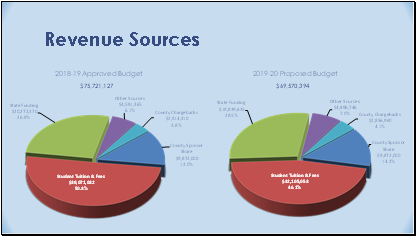
Budget:
-
Not asking for an increase in operational funds from the county, nor asking for a capital expenditure this year
-
Completing Facilities Master Plan – County has been extremely generous with capital improvements to the campus – want to make sure they are being taken care of
-
Facilities Master Plan will look at maintenance and renovation
-
Do not anticipate any new buildings, with the possible exception of a county-wide conversation in public safety. A number of public safety entities are talking about training space – may result in a facilities request, and it may be on the campus.
-
Made huge efficiency adjustments in the budget – enabled going forward without additional funding
-
Proposed budget significantly smaller than the current budget
- Had a decline in enrollment like community colleges across NYS; allowed spending less in instructional unit – particularly in part-time faculty, and in anything volume related
- Per pupil expenditure is still lower than any K-12 district or 4-year institution within 100 miles – a point of pride – that is what community colleges are meant to do – to be the most affordable higher education to a student and community
Mr. May said that he appreciates that the budget is flat, but reminded everyone that it is OK for costs to go up. We want to try to avoid sling shot fixes moving forward. With the enrollment and other things being scalable, it’s great to have a flat year, but that shouldn’t be every year – regardless of how many students attend.
Mr. May noted that he loves the box of books, adding the computer to the mix is a comprehensive, thoughtful approach – strategy and levelling of the playing field is fantastic.
Mr. May referred to the public safety training being fantastic; knows the customers are very satisfied. He is hopeful that the Syracuse Police will take a hard look at the success that everyone has had out there – maybe make it better, more comprehensive, and ideally less expensive to the taxpayers. Training is very expensive to the taxpayers – overtime for sworn officers doing the training; salary for trainees, and use of the facility. It has a considerable ripple effect on the cost of county government.
Mr. May referred to integration and programs in the K-12 format. STEAM is a big topic of discussion in Syracuse and Onondaga County, particularly in suburban districts, which was a surprise to some as it started to come together. He asked how it fits you model – funding, what the expectations are going to be. Dr. Crabill said that they have been personally involved in the STEAM school conversations and excited to participate. They are looking at a P-TECH model – a specific model that begins a program in 9th grade, and assures the curriculum is aligned so that a student can move along as quickly as he/she might. OCC has them currently with ITC and Henniger in Health and Information Tech., Mechanical Tech., Electrical Tech. The student can select the programs coming out of 8th grade. OCC will graduate the first cohort of students, who have done 5 years of mechanical tech, and had to turn down jobs to get the degree because their skill set is so sought after. They take college classes in high school when they are ready. By 12th grade they are taking mostly college with couple of high school classes; it really blends them, and they come to OCC for the 5th year to finish. The STEAM conversations are about how to take that model, starting in 9th grade, so that the students have a track – building a predictable education along the hot areas of science, technology, engineering, and math, weaving in design. OCC has been at a very granular level with the curriculum discussion. Also, NYS permits the high school students to take the college classes without tuition – cutting down for families the price of a degree. Getting a bachelor’s degree without having to pay for the first half out of pocket is really special. Dr. Crabill said that she is excited about the collaboration amongst the superintendents – they are all in and are really focused on how they can leverage this opportunity for a county-wide audience without have to build i.e. labs in Liverpool, Baldwinsville, Fayetteville, etc.
Mrs. Tassone asked if it is for all schools--where the students can take classes. Dr. Crabill said that there are some schools that are P-TECH official, a state designation with the full program integrated. There are other courses that students take in high school that are not in a specific program, i.e. Freshman English is offered in almost every high school. There are two ways to deliver instruction in high school: P-TECH and concurrent enrollment, based on the needs and capacities of the different high school districts. Dr. Crabill said that they have a lot of kids the come to OCC in the afternoon, after they finish high school around 2:00 p.m. In answer to Chair Cody, Dr. Crabill said that they get that at the satellite in Liverpool as well.
Mr. May referred to STEAM, and asked how it affects other schools and OCC in general. He noted that OCC will get state aid for the FTE enrollment whether they are at the STEAM school, high school, OCC campus, or satellite campus. Dr. Crabill agreed and stated that when they provide the instruction it is state aidable – helps to support the costs of the collaborative program. She expects she would see more prepared students in the science areas, because they have real focus in high school. Many high schools in the area struggle to have robust science labs; everyone struggles with physics because physics teachers are hard to come by. With the heavy science medical fields, there is a ton of science to get through. If they can get a good start and get the fundamental laboratory skills developed early, it really supports their progress. Regarding all superintendents being all in, Dr. Crabill said that no one is thinking about how this affects their own domain; they are thinking about how it affects the educational landscape in the region, which is an exciting conversation to be part of.
Mr. Rowley asked about the Liverpool campus and how it is going--is there is a long-term plan for it and if it is stable. Dr. Crabill said that it is stable at this point; because it’s a satellite, the enrollment tends to go up and down. Recently an Instant Admit Day was held, and almost 100 people came to sign up, apply, or see what is going on there. It is a purpose-built center; anything taken there is designed as a pathway into an OCC degree. It is structured so students can get what they need—can get about 50% of several degrees without going to the main campus. For some degrees, i.e. nursing, that’s not possible. The goal in the future is to look to offer employment certificates – a short-term, work-based training program, i.e. phlebotomy. It might serve a different population.
Mr. Rowley said that he is doing projections on enrollment in his school, and it doesn’t look good. He asked if Dr. Crabill has concerns going forward. Dr. Crabill said that it is horrible. Mr. Rowley asked if OCC has been tracking the immigrant population or the underserved population. Dr. Crabill said that was the genesis of the Weekend College – 24 years and up population because it is less credential than it needs to be on average – a group they need to continue to find ways to serve better. Some of it be in credit based programs; some of it will be non-credit based workforce programs. Most recently they have been working with the State on apprenticeship models; the state has recognizing that they can be applied to industries that might not have thought that way in the past. They have had to experience with Feldmeir and Bristol-Myers Squibb – they had a huge hiring need and unable to find people close to ready. OCC assisted them in marketing, pre-screening, the interview process, and developed a short-term training program based on what the employers’ needed. The employers’ piece was that they would hire the person from the first day of training. The employers’ made a commitment to employ the people successful in training with a progressive on-the job training piece for the next 4 years. Between the new programs, Weekend College, and non-credit training programs, she thinks those are things that will help the college grow back a little bit. She said that if they went merrily on their way saying that their market is graduating seniors, they would be one-third the size that they are today in about five years. It continues to dip across the county until this year’s 5th graders, and then it falls off again.
Mr. Jordan referred to revenue trend analysis, pg. 2-11 and page 2-13 Community College Tuition and Chargebacks-- it is on an annual basis, not a school year basis, and asked for clarification. Mr. Manning, CFO, said that page 2-13 represents what Onondaga County pays on an annual basis – Onondaga County is on a calendar year basis – these are the payments they make to other counties. Page 2-11 refers to what OCC collects.
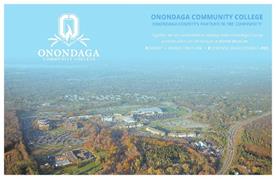
Dr. Crabill referred to the County Executive’s State of the County address and shaping his efforts around poverty, infrastructure, and economic development (PIE). OCC wanted to make it clear as to what they engage with in these areas through the county. She said that OCC sees itself as an engine of county effort and referred to the map below:
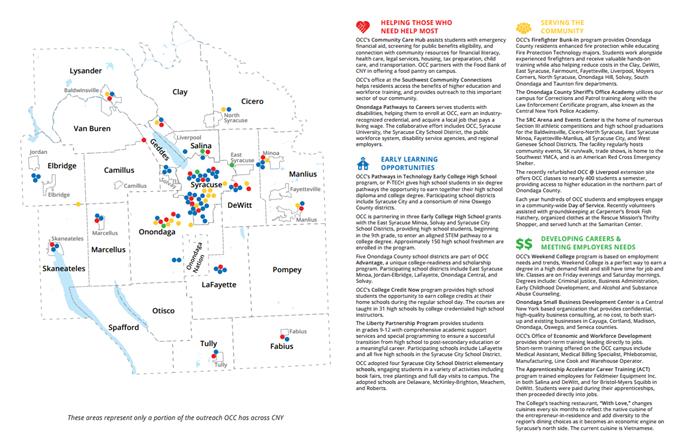
Chair Cody thanked Dr. Crabill for the presentation, the stewardship and cutting edge is appreciated.
The meeting was adjourned at 11:40 a.m.
Respectfully submitted,

DEBORAH L. MATURO, Clerk
Onondaga County Legislature
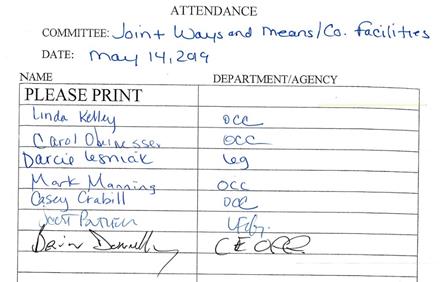
* * *
COUNTY FACILITIES COMMITTEE MINUTES – MAY 15, 2019
JUDITH A. TASSONE, CHAIR
MEMBERS PRESENT: Ms. Cody, Mr. Holmquist, Mr. McBride
MEMBERS ABSENT: Mrs. Ervin
ALSO ATTENDING: See attached list
Chair Tassone called the meeting to order at 10:32 a.m. A motion was made by Ms. Cody, seconded by Mr. McBride to waive the reading and approve the minutes of the previous committee meeting. Passed unanimously; MOTION CARRIED.
1. PARKS AND RECREATION: Travis Glazier, Director of the Office of Environment
a. Amending the 2019 County Budget to Make Funding Available for use in Connection with the Installation of Electric Vehicle Charging Station Infrastructure at Beaver Lake Nature Center, and Authorizing the Execution of Agreements ($25,934)
-
Allow for Parks to install Electric Vehicle (EV) charging stations at Beaver Lake - Fully grant funded
-
$16,000 from NYSERDA’s Charge New York and $9,934 from National Grid’s Electric Vehicle Supply Equipment funding program - should cover all costs; grant dollars are actually a little greater than the estimate for installation
-
Includes 2 dual port charging stations - as many as four cars can charge at a single time
-
Free infrastructure investment, and good opportunity for County; have electric charging stations in other facilities
-
Potential long term costs with energy usage - worst case scenario is $3,500/year, which is very high usage at 4 cars 4 hours/day for the year; based on current EVs, do not anticipate that being the case
-
Charging stations can be made for using a credit card; Parks can decide how to handle that
-
Looked at multiple facilities, and this facility could accommodate for the amount of grant based on the electrical setup
-
Installation also includes an upgrade on panel from 150 amp to 200 amp; type 2 action SEQRA
-
Long term maintenance costs – goes with facility; some are at Oncenter outdoor parking, and there have been maintenance costs based on it being an open lot and plowing issues
Mr. Lansley agreed with Mr. Glazier that Parks has two at the main office, and he said there has been zero maintenance. Chair Tassone asked how long they’ve had them, and Mr. Lansley responded four or five years. One was recently replaced with a new one. Ms. Cody asked if they have data on how much it’s used. Mr. Lansley said no, but they do have casual users once or twice a day. It is a value to those that use the park.
Mr. McBride asked if there is an obsolescence to them, and do they need to be replaced over time. Mr. Lansley said he guesses that they do. The old one had a hanger to put the cable on when not charging (some people would leave it on the ground), and the new one has a retractable cord; which is a lot nicer. Mr. Lansley stated that they were not notified about the new one being installed as a replacement.
Chair Tassone asked what the life expectancy is, and Mr. Lansley replied he does not know; but they should last a while since there is not much to them.
Mr. Glazier responded to Ms. Cody that there will be two stations that can accommodate four cars. Also included are two bollards with each station to prevent cars from knocking it over.
A motion was made by Ms. Cody, seconded by Mr. McBride, to approve this item. Passed unanimously; MOTION CARRIED.
2. CNY ARTS: Stephen Butler, Executive Director
a. Amending the 2019 County Budget to Make Funds Available to CNY Arts ($125,000)
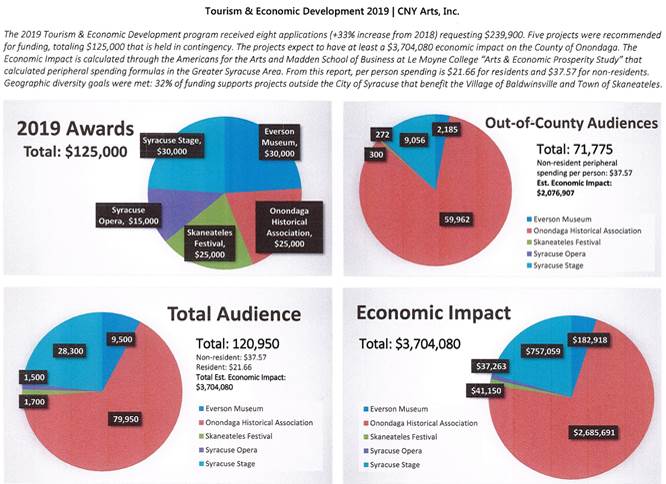
-
This year made attempt to look county wide, since it’s funded through ROT - project in Baldwinsville and Skaneateles
-
CNY Arts gets to administer program and bring in panelists that use written guidelines
-
Panel chooses the projects with best economic impact; then bring here for Legislature’s approval
-
Talk to those people that did not receive funding; they can review comments on their apps; encouraged to apply again
- Pop opera – probably most unusual idea
Chair Tassone asked for the names of the other three that applied, and Mr. Butler responded that they do not make those public since they did not win. Mr. Butler can provide Chair Tassone with the names of all that applied and any other inquiries.
Ms. Cody said she has heard of the Brewseum by the Onondaga Historical Association and asked where it is going to be. Mr. Butler responded it is at the Iron Pier near Inner Harbor. This project will have more return on investment with people coming back year after year, versus other projects that are one year. This was very intriguing to the panel. Ms. Cody said she likes to see things in Inner Harbor including the Creek Walk, Loop the Lake and others. Mr. Butler explained that this project was funded a couple years ago when it was going to be along I81, but because of it not being viable to move forward, they withdrew and resubmitted.
A motion was made by Ms. Cody, seconded by Mr. McBride, to approve this item. Passed unanimously; MOTION CARRIED.
The meeting was adjourned at 10:48 a.m.
Respectfully submitted,

JAMIE McNAMARA, Assistant Clerk
Onondaga County Legislature
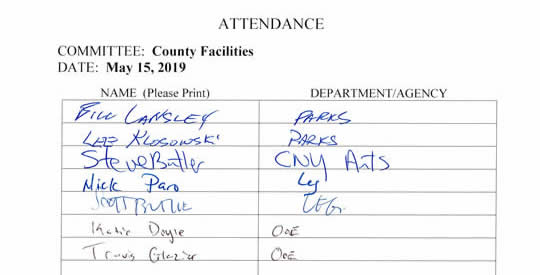
* * *
PLANNING & ECONOMIC DEVELOPMENT COMMITTEE MINUTES – MAY 16, 2019
JOHN D. McBRIDE, CHAIRMAN
MEMBERS PRESENT: Mrs. Abbott-Kenan, Mr. Burtis, Mr. Holmquist
MEMBERS ABSENT: Mr. Buckel
ALSO ATTENDING: Chairman Knapp; see attached list
Chairman McBride called the meeting to order at 10:32 a.m. A motion was made by Mrs. Abbott-Kenan, seconded by Mr. Burtis, to waive the reading of the proceedings from the previous committee. MOTION CARRIED. A motion was made by Mr. Burtis, seconded by Mr. Holmquist, to approve the minutes of the previous committee meeting. MOTION CARRIED.
1. CULTURAL RESOURCES TRUST:
a. Confirming Reappointment to the Trust for Cultural Resources of the County of Onondaga (Gregory Lancette)
Chairman McBride said that Mr. Lancette has been on the board for a number of years and has done a stellar job.
A motion was made by Mr. Holmquist, seconded by Mrs. Abbott-Kenan, to approve this item. Passed unanimously; MOTION CARRIED.
2. SYRACUSE PLANNING AGENCY: Dan Kwasnowski, Director
a. Approving the Inclusion of Viable Agricultural Land within Certified Agricultural Districts Pursuant to Section 303-B of the New York State Agriculture and Markets Law
Mr. Kwasnowski:
-
Briefly reviewed last month; public hearing scheduled for June 4th, 12:55 p.m.
-
All additions in Agricultural District 3, Lysander and Van Buren
-
Elbridge parcel excluded, inappropriate - explanation contained in the prepared report
-
Resolution contains the final list of recommended parcels, many owned by Reeves 1000 acre farm, adding pieces that support the farm with tillable land or ponds used for irrigation; ok to have buildings on support land property
-
One parcel more forested, old orchard, located in Van Buren; 78.68 acres total, well vetted by the Farmland Protection Board which he is a member of
In answer to Chairman McBride, Mr. Kwasnowski confirmed that Legislator May is also on the Farmland Protection Board.
A motion was made by Mr. Holmquist, seconded by Mr. Burtis, to approve this item. Passed unanimously; MOTION CARRIED.
A motion was made by Mr. Burtis, seconded by Mrs. Abbott-Kenan, to adjourn the meeting at 10:37 a.m. MOTION CARRIED.
Respectfully submitted,

KATHERINE M. FRENCH, Deputy Clerk
Onondaga County Legislature
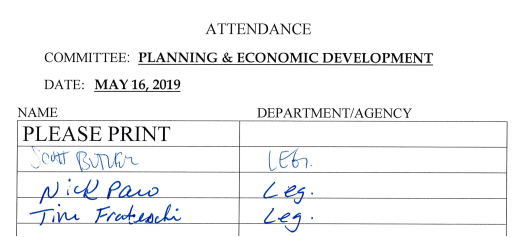
* * *
WAYS & MEANS COMMITTEE MINUTES - MAY 21, 2019
DEBRA CODY, CHAIR
MEMBERS PRESENT: Mr. Ryan, Mr. Rowley, Mr. Jordan, Mrs. Ervin, Mr. May
MEMBERS ABSENT: Ms. Williams
ALSO ATTENDING: Chairman Knapp, Mr. Bush, Dr. Chase
Chair Cody called the meeting to order at 9:20 a.m. A motion was made by Mr. May, seconded by Mr. Ryan, to waive the reading and approve the minutes of proceedings of the previous committee. PASSED UNANIMOUSLY; MOTION CARRIED.
Chair Cody took the agenda out of order.
9. COMPTROLLER: Matthew Beadnell, Comptroller
a. Comprehensive Annual Financial Report – Matthew Beadnell, Comptroller
Mr. Beadnell noted that the CAFR was delivered to legislators yesterday. He presented the following document for the record, and reviewed the various components of the CAFR.
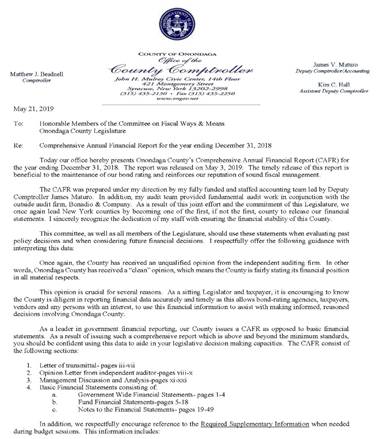
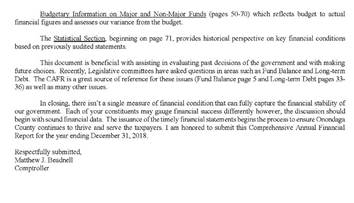
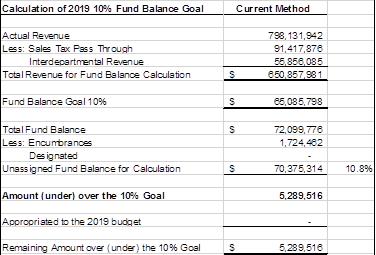
Mr. Beadnell:
- General Fund - sales tax $13.9 million over budget/$17.8 million over 2017
- Offset the planned use of $5 million in fund balance
- Resulted in a $5.1 million operating surplus
- 10% goal – went from 9.3% in 2017 to 10.8% in 2018
- $5.3 million over the goal; no appropriation in 2019
- Referred to the independent auditors report on internal controls:
- Greater Syracuse Soundstage Development Corp. - a deficiency in internal controls was found
- Considered to be a material weakness
- Valued at $8 million worth of assets at the purchase price of $1
- Required numerous material audit adjustments
- Audit firm had to inventory and value the assets received from Fort Schuyler Management Corp.
Mr. Beadnell explained that the numbers are in the equipment associated with the Film Hub. Mr. Ryan said that the equipment in it was labeled as a deficiency, and asked if that is now corrected. Mr. Beadnell said that it was corrected through the course of the audit. Mrs. Ervin asked if this was a one-time occurrence. Mr. Beadnell said that he believes it to be one time; he can’t guarantee if they acquire any more equipment, that they will do it correctly. He explained that the nature of the dollar amount is why it is incorporated in the consolidated financial statements.
Mr. Rowley said that Mr. Beadnell had stated that the county has to stand by accounting standards and incorporate their financial statements with ours. He asked what that means from the comptroller’s perspective as an auditor. He asked if the Film Hub gets in trouble, does the county have to bail them out. Mr. Beadnell said that he believes they are legally a separate entity, but are so closely related that we are required to present them in the financials. He said that the Comptroller’s office has the ability to help out in any capacity of guidance on a county policy on how to present things, and had this entity come to them during the course of the audit, this would have been avoided. Management of this entity did not come to them, which is why this is in the report. Mr. Maturo said that the only three board members are high ranking county officials and deferred to Mr. Morgan to answer Mr. Rowley’s question. Mr. Morgan said that the answer to is “no.” Mr. Morgan said that the county doesn’t have a responsibility at all if there happens to be a financial issue there.
Mr. Morgan said that in terms of the audit from 2018 and the failure to record the value of the property of the building, it was quite honestly an oversight. It was a material change to the financials, which they accept. He expects that it won’t be seen in the future. The Greater Syracuse Sound Stage, LLC, created to manage that property and operation. It is being managed from a perspective of increasing the revenue, to the extent they can, by leasing the property to various entities and leasing the soundstage itself. From a financial perspective, it is moving in the right direction. A couple grants were procured through the state for capital and operating purposes. Expects that an operating deficit won’t be seen for 2019.
Mr. Jordan asked if the net effect was a decrease to the county owned assets for having to report that on our financial statements as essentially an asset – originally listed as a lower value, now listed as a higher value. Mr. Beadnell said that the way the standards read is that is what we believe the value of that building and equipment are today.
Mr. Beadnell continued:
- Modest rebound in cash this year, $309,000 overall, approximately $2 million in general fund cash
- Presented high level concerns in the past – not a huge concern, but cash has dropped significantly over the last five years.
Mr. May said that a year ago cash flow was a stated concern – we are $2 million better, but has there been improvement with respect to how we are going after the dollars that we know are out there. Whatever the liability is to the county, are we doing better as an organization in getting those dollars back. Mr. Beadnell said that he thinks so; there were decisions made to use cash as opposed to borrowing in the past. He said that when the concern was raised that cash had dropped significantly since 2015, people are looking at it more closely. Mr. May said that in terms of internal operations and financial decisions being made by departments. Mr. Beadnell agreed.
-
Overall from 2015 the general fund is down $47.6 million; that is our true operating, general fund cash; a small rebound this year, that is still the overall theme in the last four years; it is early in 2019 and hard to forecast what it will be
-
Debt is an area of concern – not near our limit, but that shouldn’t be a goal to get to
-
Authorized and unissued is up slightly - $218.2 million at end of 2018 – money authorized but not borrowed - over the course of next 2 years, it is money that will be borrowed
-
Total debt up $9.4 million; serial bonds up $17.6 million; EFC loans down to $8.2 million
-
Over all 2018 was a very good year: brought fund balance up to a comfortable level – legislature should be proud of that with its decisions to help get that back up
-
CAFR filed May 3rd; Annual Update Document to the State Comptroller filed beginning of April – a required report
-
With office being staffed the right way, we can look forward consistent, timely reporting going forward
1. ONONDAGA COMMUNITY COLLEGE:
a. Adoption of Annual Budget for Onondaga Community College for the Fiscal Year Sept. 1, 2019, to Aug. 31, 2020, and Authorizing the Co. Executive to Enter into Contracts with other Governmental Units in which Appropriations and Revenues are Approved by the Adoption of the 2019 Budget
Chair Cody said that the public hearing was held this morning; no speakers. The committee has reviewed the budget.
A motion was made by Mrs. Ervin, seconded by Mr. Ryan, to approve this item. AYES: 5 (Jordan, Rowley, Ervin, Ryan, Cody; Out of room (May). MOTION CARRIED.
2. ONONDAGA COUNTY/SYRACUSE COMMISSION ON HUMAN RIGHTS: Barry Gewanter; Exec. Director
a. Confirming Appointments to the Onondaga County/Syracuse Commission on Human Rights (Chol-Awan A. Majok, Tricia A. Wittkowski, L-CSW)
- County executive’s appointments
- Filling positions as a result of resignation and death
A motion was made by Mrs. Ervin, seconded by Mr. Ryan, to approve this item. Passed unanimously; MOTION CARRIED.
3. FIRE ADVISORY BOARD:
a. Confirming an Appointment to the Onondaga County Fire Advisory Board (Paul Hildreth)
- County Executive’s appointment
- Fire Chief, Village of Fayetteville
A motion was made by Mr. Ryan, seconded by Mr. May, to approve this item. Passed unanimously; MOTION CARRIED.
4. COUNTY CLERK: Chris Plochocki, Deputy County Clerk
a. Mortgage Tax Apportionment
- Covers period from October – March
- Total $3,555,538.80
- Down 15% from previous period; up about half a percent from the same period last year
- Trend to be down through winter months
A motion was made by Mr. Mary, seconded by Mr. Jordan, to approve this item. Passed unanimously; MOTION CARRIED.
5. CNY ARTS: Steve Butler, Executive Director
a. Amending the 2019 County Budget to Make Funds Available to CNY Arts ($125,000)
-
Request release of contingency funds for economic development grants for organizations
-
Formula based on work with the Madden School at LeMoyne in combination with Americans for the Arts to determine what each grant will generate four the county and quality of life
-
Do not distribute funding directly – all goes through a panel of peers and experts who make those decisions
-
Asked panel to look outside of city – hotels and motels across the county
- 2 projects – Skaneateles and Baldwinsville outside of the city
- Brewseum – Inner Harbor – as a longer shelf life, once established, it will continue to draw
Mr. May said the likes the analysis done in this competition – leads to a place that makes great sense for those applying and levels the playing field a little. Mr. May asked to co-sponsor the legislation.
Mr. Jordan said that he reviewed the criteria used to determine funding, but noted that it doesn’t seem fair. He referred to OHA – generates 66% of economic impact in attendance, but are getting $25,000 compared to others who are getting more. Mr. Butler said that is the full amount that OHA asked for, and they are not allowed to give more than the request.
Mr. May said that this is an increment over and above the annual funding process; it’s nice to have for these other groups. Mr. Butler referred to the general operating noting that CNY Arts requires a quarterly report on their attendance; they are required to provide all of their zip codes. Zip code analysis is done to figure out which percentage aggregate are coming in from out of town. They are held to a rigorous standard – they understand that they have a responsibility to provide quality of life and artistic excellence, generate the economic driver that that arts industry should be, and not rest on their laurels.
A motion was made by Mrs. Ervin, seconded by Mr. Jordan, to approve this item. Passed unanimously; MOTION CARRIED.
6. COUNTY LEGISLATURE: Deborah Maturo, Clerk
a. Standard Work Day and Reporting Resolution
- Next round of reporting/resolution required by NYS
- Will continue for the next couple of months as people come on
A motion was made by Mr. May, seconded by Mr. Jordan, to approve this item. Passed unanimously; MOTION CARRIED.
7. MISC.: Chairman Knapp
a. Onondaga County Endorsing Resolution for NYS Funded Aviation Capital Grant Program (Sponsored by Mr. Knapp, Mrs. Abbott-Kenan)
- Skaneateles has a small airport on west side of lake
- Occasionally they apply for state grants to help improve safety and operations of the airport
- Have been awarded a grant but need a resolution of support from the legislature; have done this before
Mr. May said that basically we are a sponsor. Mr. Jordan said that it’s basically to expand the length of the runway. Chairman Knapp agreed, and they are doing some trimming – not a major project.
A motion was made by Mr. Jordan, seconded by Mr. May, to approve this item. Passed unanimously; MOTION CARRIED.
8. PARKS AND RECREATION: Travis Glazier, Dir., Office of Env.; Bill Lansley, Commissioner, Parks
a. Amending the 2019 County Budget to Make Funding Available for use in Connection with the Installation of Electric Vehicle Charging Station Infrastructure at Beaver Lake Nature Center, and Authorizing the Execution of Agreements ($25,934)
Mr. Glazier:
- 2 grants: National Grid $9,934, NYSERDA $16,000
- 2 dual plug charging stations at Beaver Lake Nature Center
- Grants cover entire cost of installations and upgrade a panel from 150 amp to 200 amp
- Plugging Stations Online – installer – Albany Based Company
-
Looks at many locations for this; Beaver Lake Nature Center made the most sense regarding where infrastructure exists without having to invest a ton of extra money
-
Power used will be covered by a charge at the station or by Parks Dept. – a decision is being made on that
-
Current charging station at main office by Salt Museum – Mr. Lansley: issued a card to use it if you have a vehicle, but no cost to user – funded by the agency that supplied the machine
-
Useful life is 10 years
-
Can be used by all car manufactures except Tesla
-
Technology: one advancement coming in DC fast charges which do 200-600 miles on an hour charge – much more expensive; these will do 20 – 25 miles on an hour charge
Mr. Jordan asked what the anticipated electric costs will be. Mr. Glazier said that they ran a worst case scenario. There are four plugs; if all were being used for 4 hours a day, every day of the year, $3,500 would be the impact – that’s extremely ambitious. There is an option to put a charge on it to use a credit card. He noted the Beaver Lake Nature Center has the only solely county owned solar panel.
Dr. Chase asked how the location was determined as a place that it would be used; was there an audit of what kinds of cars are coming into Beaver Lake. Mr. Lansley said that it’s a nature center, the users are very environmental and drive a lot of hybrids; there are electric vehicles there. This seemed to be the most likely site to get used by the public. Dr. Chase asked if legislators will be able to see how much usage they get. Mr. Lansley said that they can and a report will be generated.
Mr. Ryan asked if the solar panels provide the power for the stations. Mr. Glazier said they don’t – solar panels were put in 2010 or 2011 – provide power for the facility and building. Mr. May said that it doesn’t go to the grid and come back. Mr. Lansley agreed, noting that it is small portion – maybe 10-15% of consumption taken.
Mr. Jordan asked if there are solar panels for the charging stations so that they are self-powering. Mr. Glazier was not familiar with that technology. Mr. Lansley noted for comparison that the Park’s tram is battery powered with solar panels on top – it supplements the daily – there are 26 batteries that it takes just to operate the tram. The batteries can’t be powered even with the four large panels on the roof. Mr. Klosowski said that they wouldn’t be able to be used for the charging stations to charge a vehicle.
A motion was made by Mrs. Ervin, seconded by Mr. Ryan, to approve this item. Passed unanimously; MOTION CARRIED.
b. Amending the 2019 County Budget to Make Funding Available for a Mower Purchase for the Onondaga County Veterans Memorial Cemetery ($33,799)
Mr. Lansley:
- $204,756 in perpetual care account
- Previously the charge for a plot was roughly $500; $50 was taken out and put into an account to generate interest – doesn’t touch the burial fees
- Expanded cemetery 4 times in last 9 years – over 6,500 burials
- Purchase 96” diesel Zero Turn EXMARK (U.S. made) – will greatly increase efficiency
- No impact on budget – just releasing what is there
- Mower will only be used at Veteran’s Cemetery – will not be transferred to other properties
Mr. Jordan asked if mowing is being done where there aren’t graves. Mr. Lansley said they that are – just opened another acre. Mr. Jordan said 96” is big and can’t imagine mowing can be done around graves with it. Mr. Lansley said that all gravestones are flat.
Mr. May said that one mower is down. Mr. Lansley said that they supplement with the mower roll out crew. Highland Forest has most of the mowers in the southern district – they trailer them; they come through and do a bulk of the work. This mower will reside only at the cemetery. The roving mower crew goes out once/week. This time of year the grass grows fast; this will allow keeping up locally.
Mr. Rowley asked why the budget needs to be amended; why can’t it go through the Vehicle Use Review Board and grab the money that way. Mr. Morgan said that the enabling legislation requires the legislature’s approval to collect this money.
A motion was made by Mrs. Ervin, seconded by Mr. May, to approve this item. Passed unanimously; MOTION CARRIED.
10. FINANCE: Steve Morgan, CFO
a. Memorializing New York State to Enact Legislation (A. 7288-A/S. 5278-A) in Relation to Open Auction Public Bond Sales Through an Electronic Open Auction, and Requesting and Concurring in the Preparation of a Home Rule Request
- Legislature passed a resolution requesting the state to allow for the county to use the open auction process
- Now have Senate and Assembly bill ready to go; now have to do a Home Rule
- There is some discussion about there being a state-wide approach
A motion was made by Mr. Rowley, seconded by Mr. Ryan, to approve this item. Passed unanimously; MOTION CARRIED.
b. Monthly Report - Double Encumbered Positions (Res. 86-2018)
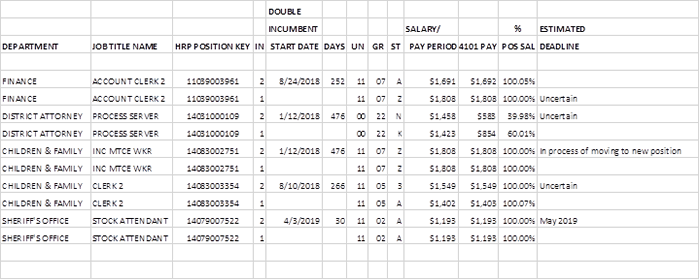
- Same as last month’s report
- Thought sheriff’s item would fall off – expect it will before next reporting
Mr. Jordan asked if the Sheriff’s positions will be leaving this month. Ms. Venditti said that it was timing – they were coming off May 2nd; report was run May 3rd.
c. 1st Quarter Report - Steve Morgan, CFO
- Referred to Comptroller’s comment about unissued and unauthorized debt of $218 million
- Roughly $154 million of it relates to sewer fund; a good portion of unissued debt paid is outside of general fund
Mr. Ryan asked about the amount raised for the sewer fund in the last budget. Mr. Morgan said it was raised $25 in the last budget cycle – it was $4.11; now it’s $4.36 or $4.37. Mr. Ryan said that it was also raised before that. Mr. Morgan agreed; there was a desire from the previous county executive to get a certain amount of sewer rate increase over a 5-year period – looking for 25%. It fell short of that because some years it was proposed and the legislature didn’t support that increase. The need to appropriate an appropriate level of sewer unit charge will continue to go on.
Mr. Ryan asked if there is anticipation of increasing sewer unit charge again this year to offset future costs. Mr. Morgan said “that is always in play”. The county executive has talked about his desire to approach our sewer infrastructure in a consolidated way. There will be a lot of discussion about how to pay for that. Starting in 2020 budget, there will be a strategy on how to address it.
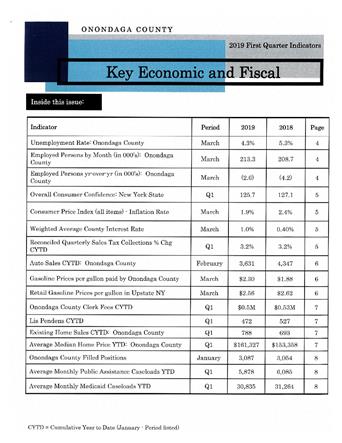 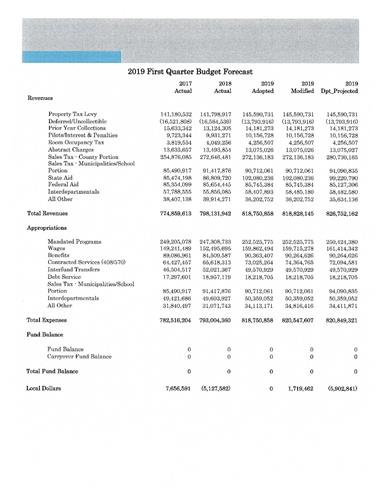
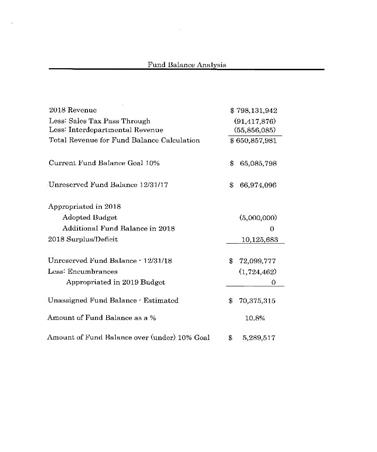 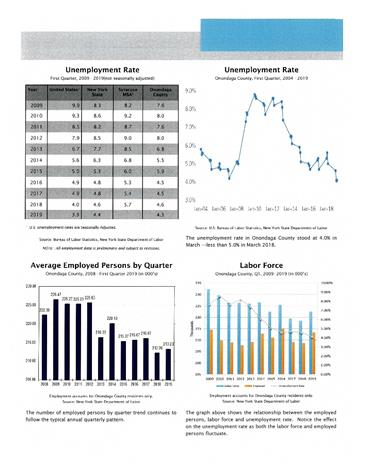
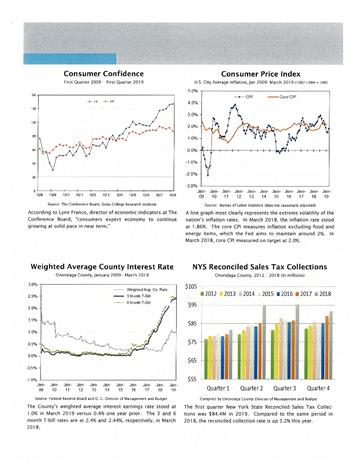 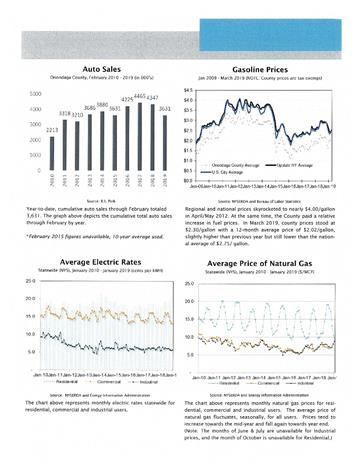
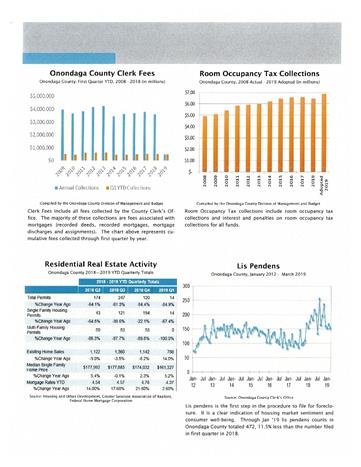 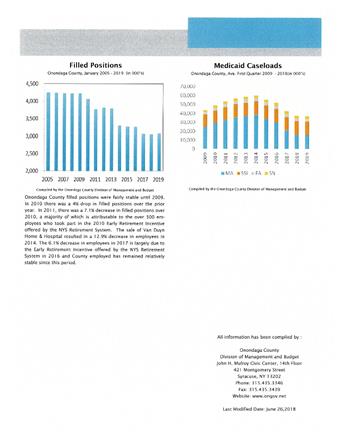
- Most fiscal indicators are moving in a positive direction
- Projections near $6 million surplus at this time – almost exclusively related to the strength in sales tax collections
REVENUES:
- 2019 budget predicated on 3.5% growth in 2018 over 2017; another 3% growth in 2019 over 2018
- Ended 2018 with 7% growth; if sales tax collection stays flat, we will still be over budget
- Projection at this point is $280 million
- Current growth is 5.3% - have 2 payments into May
- Most other revenues are at budget; state and federal aid projected to be under budget – related to mandate spending
EXPENSES:
- Mandates: projecting $2 million surplus; seeing good things in temporary assistance, but struggling with foster care
- Ended 2018 with with $4-$5 million deficit in foster care – projecting almost the same this year
Mr. May said that the opioid situation has been a big driver in the foster care situation; asked if it continues to be the case. Mr. Morgan said “absolutely.” The county is involved in the opioid lawsuit that was brought forward. Information was provided to the Law Department regarding potential fiscal impacts related to that. It’s tough to identify. Regarding kids in care and cost, he said that it ebbs and flows – the number of kids in care should be the rights number. It’s not a fair statement to say that there are too many kids in care. That work needs to be ensured – appropriate placements and are doing everything we can to either reunite those children with their natural parents or find permanency in other fashions--typically adoption. He said that it has been over the budget; they are aware of it – to an extent it is a budgeting issue – will look to right size it in 2020.
- projected to be over budget – large portion is OCSPA settlement
- Did not budget for salary increases related OCSPA agreement – hope that it falls in line further down the year
- Won’t touch that budget unless need to
- If payroll goes into the red, will work with Comptroller’s office to address it
Mr. May said that in Public Safety Committee we will see departmental projections. He understands that the settlement is in the Sheriff’s actual budget. Mr. Morgan said that the projection is, but it was not added to the Sheriff’s budget to include the impact of it.
In answer to Mr. Ryan, Mr. Morgan said that it is in the forecast, but it wasn’t budgeted for, nor has the budget been amended for it. Mr. Ryan referred to DSBA. Mr. Morgan said that it is currently being negotiated; when that settles, it will impact the budget as well – it was not budgeted for and will have to deal with it. The major contract is CSEA, which is good until the end of this year. A decision will have to be made about putting something aside in provision for salaries and wages or let it ride and deal with it as it comes. Mr. Ryan asked about Department of Correction, and was informed that they are CSEA. Mr. Morgan said that is a smaller portion of people. Mr. Ryan said that the cost would still have to be absorbed. Mr. Morgan agreed, but explained that it is not more people, just a different union.
Mr. Rowley asked about the $1.7 million modified. Mr. Morgan explained that certain spending ability is carried forward from the previous year. Typically fund balance would be carried over, and there is actually a row for it. It is questionable as to whether or not it should be recorded as a revenue. Some of the spending authority rolled forward has revenue behind it, some of it doesn’t. For this forecast, no fund balance carry over is included. Any revenue to offset those expenses would be a plus.
Mr. Jordan noted that the projection is to come in under budget on contracted services, which is a larger number than the increases in wages. Mr. Morgan agreed, noting that overall expenditures are expected to be only $300,000 over budget at this point. Most can be attributed to the OCSPA settlement.
Mr. Ryan asked about the gasoline tax projection. Mr. Morgan said that fuel prices have increased – do not construct the budget by commodity. Sales tax is estimated on a global basis; the moving in fuel prices at the pump is a positive impact on sales tax collections.
Mr. Jordan referred to gas prices, noting that in 2018 the county was paying about $.80/gallon less than the average retail price, but in 2019 we are about $.26 below the average retail price. The retail price has gone down in the last year, whereas the cost to the county has gone up $.42/gallon. Mr. Morgan said that he didn’t know why, and would report back to Mr. Jordan on it.
Fund Balance Analysis:
- 2018 budget – appropriated $5 million to balance the budget
- Ends 2018 in a position not to use any fund balance that was appropriated
- Added $5.1 million to fund balance
- Resulted in unreserved fund balance being $72 million, taking out encumbrances brings it to $70 million
- 10.8% of general fund revenues
- End 2018 positive--mainly from sales tax growth 7% - allowed not tapping into any fund balance, and add to it
- $0 appropriated in 2019 budget
- At over $70 million – $5.3 million over the goal
- $70 million lower than what it has been in the past, but a more accurate reflection of where we need to be
- It’s better formula and depiction
Mr. Morgan said that they met with the bond rating agencies who came to town and were given a tour of some of the economic projects. In looking a few of the rating agencies’ metrics in what they use to determine ratings for municipalities, some of the expectations around fund balance are unrealistic. One rating agency is looking at 20% – 30% fund balance as percentage of revenue. That would mean the county would have to have roughly $200 million in fund balance to get a positive outlook from them in that metric alone. He said that some of the measurements are subject to an extent; consistently applied to all municipalities, but some are really out of reach for Onondaga County – not only from a financial perspective, but also common sense perspective.
In answer to Mr. May, Mr. Morgan said that is one agency’s metric, and higher marks are given for having a higher fund balance as a percentage of operations. Mr. May said that it might make sense for $5 million town, but in a $1.3 billion enterprise it is ludicrous. He questioned what it would do to the ability to borrow; Mr. Morgan said that you would just use cash.
Mr. Morgan said that this legislature is comfortable with the 10% of general fund balance, but pointed out that in the rating world, it is on the low side.
Mr. Ryan asked how many municipalities are at 30%. Mr. Morgan said “not many.” Mr. Ryan referred to the Town of Geddes, noting that the cost of business always goes up and never goes down. He would think that a smaller town or village wouldn’t come close to that percentage. Mr. Morgan said that the agency he is speaking of has not rated any counties with an AAA rating. Their metrics are a little on the aggressive side. Mr. Donnelly said that they are also looking at the metrics nationwide and do not have metric solely for New York State. To hold that much in fund balance would be ludicrous, and you wouldn’t be able to justify it.
Mr. Jordan said it would depend on what it is based on – if on the local levy, it would be a lot lower than the overall budget. Part of it isn’t really revenue that is locally generated; some is generated by the federal and state governments.
Chairman Knapp referred to fund balance and reminded everyone that one goal in the 2019 budget – the budget came over using $1.5 million and the legislature found ways to eliminate that.
Chair Cody noted that there is an additional item:
Mr. Bush said that he wanted to have a discussion about the real property transfer tax.
-
June 15th – drop dead date to submit a resolution to the state legislature for a home rule
-
If we are going to do anything, it has to be done at the June session
-
County Executive wants the legislature to seriously consider a proposal that he has worked on; worked with state delegation, who is willing to advance it
-
$3/$1,000 transfer fee to be divided up: 1/3 for land bank; 1/3 for infrastructure; 1/3 for arts
Land Bank:
- County is not funding the land bank this year – puts them in a difficult situation
-
Has to decide if it wants to help this organization that has done a lot for our community; continues to work very hard on revitalizing neighborhoods – maybe not as fast as we would like, but are in areas that are very challenging
-
They are working in the greater Onondaga County area on a different scale – not dealing with blocks of neighborhoods, like they are doing in the city, but are doing a house here or there – impact is the same, on a smaller scale
Infrastructure:
- One that we will be facing; rate payers are going to have to pick up a lot of the costs
- Any funds we can get to help with those costs are going to be sorely needed
Arts:
- Hopes vote can take place at the June meeting and pass the resolution to the State to act on it and give authority to do this
Ms. Wright, Land Bank, noted that they gave their annual report in March and demonstrated that the monies that the city and county have put into the land bank so far have been net positive for both municipalities. Funding the land bank and keeping it going has helped the city be a much better collector of taxes on behalf of themselves and the county. There is more delinquent tax revenue coming into the county as a result of what has been invested so far – expects that to continue. Properties sold are going back on tax rolls. It’s a sound investment on the fiscal side, and also added benefits regarding neighborhood revitalization and quality of life.
Ms. Wright said that another concern that was raised is if the $1.5 million per year to the land bank is secured, does it let the city off the hook in that they do not have to continue paying for this. The concern was voiced by Assemblyman Magnarelli, who has been willing to sponsor at the state level. He requested that the mayor and the president of the common council to write letters to him indicating that if this funding is secured that the city will continue to fund the land bank. They both made that commitment.
Mrs. Ervin asked if the state delegation is fully behind this at this point. Mr. Bush said that according to County Executive McMahon there have been negotiations with Senator May and Assemblyman Magnarelli, and both will carry it. They obviously can’t commit the vote.
Chair Cody asked if there was anything in writing at this point. Mr. Bush said that there was not; that would be coming from the County Executive’s office.
Mr. May said that when he heard this coming up last night, he was surprised to a degree, and a little upset about it. He said that he came up with some of the features of this quality of life, transfer tax proposal to address some big county-wide issues that we are all facing day to day. There is the proposed tourism district issue from the hospitality industry. There is the issue that legislators face regarding the effectiveness and/or opportunity costs associated with funding the arts through room occupancy tax – we don’t get the return on investment that we get from other things that we spend ROT on. It is important to continue to fund the arts, but how do we accomplish all of these things that everyone wants and know they are good for the economy.
Mr. May said the second concern is the efficacy of appropriations for the land bank – does it make sense for the county to continue to fund the land bank from the general fund when we have an obligation to create another revenue stream that preserves its mission and continue to do the good work that it is doing for the county and local municipalities.
Mr. May said that throwing in infrastructure wasn’t his idea, but it is a good one. He said that we all have an obligation moving forward to follow through on our commitments to the towns with the sewer takeover strategy. Whether a municipality has solid infrastructure, up to date, and running very well, or, whether they have low – we have equal responsibilities to all of these municipalities year to year. Within this component there is an opportunity to try to take care of that obligation.
Mr. May said that he was glad to hear there is interest from the Assembly. It is a shame that it wasn’t 5 or 6 months ago, when this dialogue started. This puts us all in a tough spot – looking to make a decision in 2 or 3 weeks. He thinks there is a great business case to be derived from this in all 3 functional areas. That business case is purely to benefit taxpayers with return on investment – thinks we can generate sales tax, offset some other expenses that we take on and position those expenses appropriately as we move forward. He said that the quality of life improvements through this are worthwhile. Not just having better working neighborhoods, but making sure the arts are funded in perpetuity in a really good way.
Mr. May said that he is afraid that the business case can’t be presented to each other in detail. There is no time for the due diligence. He asked how we know that the state is truly on board. The business case needs to be built. He thinks it can be, but questioned doing it in two weeks.
Mr. May asked what the basis for the now or never ultimatum is. Mr. Bush said that it is the timeline. This has been discussed for weeks on and off. Because of the calendar for submitting, in order to get Home Rules submitted, the 15th of June is our drop deadline. Mr. May said that he doesn’t understand it being a “now or never” ultimatum. Mr. Bush said that if we want to get this in play, the deadline is June 15th, to get a revenue stream going – otherwise, it is off for a year based on the state legislature’s calendar. Mr. May said that anecdotally he heard it was “now or never”; we need to know if we are going to make a decision.
Mr. May asked “how do you walk out of this room and say in a couple of sentences what we are going to do for this community by creating this new tax?” Mr. Bush said that it is what can be done with the additional revenue, particularly in his case, for the land bank because he has seen the impact on neighborhoods. They need the resources to do the job. They are investing in some areas that are not good investments for private enterprises. If it weren’t for an organization like the land bank, any sort of development wouldn’t be seen – even if it means taking down a house for safety reasons. It gives a neighborhood hope. They can’t turn things around as quick as we’d like – they don’t have the resources to do that. He can see what they do in the outlying areas as well--in towns, villages, and hamlets where maybe it’s just one house. In the city they are taking down 2 – 3 houses – with additional revenue they could expand. He said that he drives around the city and sees some of these boarded up homes that is just a tragedy for a family that tries to keep their house up and they have to live next to a piece of real estate like that. “We have to attack the issue; the land bank has been doing the best they can do.” He said that if they are not going to get funded from the state, somebody has got to pick it up or we let the whole thing collapse or diminish to the point where they can maybe limp along.
Mr. Bush said that the other two-thirds of the revenue is going for very good programming. It’s not his positions to say where the money will be spent – the money will come in, be allocated, and it will be decided own what projects warrant it. Mr. May said that this validated his concern – that we understand one third of this. He said that we all agree that the land bank is doing good work; there are issues for discussion within the land bank component. One third can be worked out through a process – what about the other two-thirds. He said he helped create some of the ideas, but they haven’t been ironed out.
Mr. May asked from a holistic perspective – proforma, prospectus, budget, on the dollars we think we are going to raise and generally how they will be used – beyond the highest category of application. Mr. Bush said that a rough estimate of anticipated revenues is approximately $4 - $4.5 million; the economy has something to play. Mr. Bush said that other than the land bank, the questions should really be addressed to the county executive – in their budgeting, their allocation of resources, with approval from the legislature. He said that the county executive has been the one that has been the driving force in trying to get additional revenue for those two areas. That is why it has been incorporated as a package.
Mr. May asked if it is additional money in respect to the arts, or are we moving the arts out of ROT. Mr. Bush said that would be a legislative decision. Mr. Donnelly said that he understands that it would come out of ROT. There is $1.2 million in ROT now for the arts/cultural – this proposal would bring in about $4.5 million. Mr. May asked what is associated with that process legislatively. Mr. Donnelly said that it would be stipulated within the budget as to the allocation process. There would be the ability to use ROT for economic development purposes as it was intended, and have this be another category.
Mr. May said that in concept he supports this, but referred to revenue scales – changes based on the economy. He asked if this revenue stream will fund these three initiatives; is it just going to scale and whatever it is gets appropriated three ways. He questioned what happens if we have a down year and we fall short – what is our obligation. Mr. Bush said that goes beyond the scope of the resolution – that would be done as part of the budget cycle. Ms. Venditti said that any revenue would be subject to appropriations.
Mr. May referred to the land bank - the mission, the goal, the accomplishments – have seen in his town; in caucus have talked about the surgical approach in the suburbs where you can fix a neighborhood with a house. In the city, you have to take on blocks to fix a neighborhood. He does not have any discrepancies between dollars and time spent. He said that he will want to understand how this revenue will change operations for the land bank. He referenced financial information received from land bank – a budget response received several months later, and he couldn’t understand it. In going through the annual report, he gained a little more clarity – talked to the Comptroller, who looked at both pieces of information, and the business model wasn’t clear. He wants to understand that as well.
Mr. May said referred to ROT – sliding the arts out and funding through the transfer tax. He said that his motivation for bringing up the idea was to tackle the tourism improvement district (TID) within the arts. Mr. May said that if this tax increase is pursued, we have to make sure that is accomplished. Therein lies the return on investment – most of us believe that if we put more money toward that industry, we receive exponential returns on investment. When talking about a business case, or creating a tax increase, we want to drive toward a solution that we can show anybody that we are doing the right thing. He wants to talk about financial process, financial controls, and accountability with respect to the dollars that the county is raising.
Mr. May referred to infrastructure; thinks all agree we need to spend money on it, but what exactly are we going to do. The town stuff is a great idea and great time to do that, whether this is passed in two weeks or sometime in the future, we have to do that. There is a lot we don’t know. There is a good business case to be had; there is a ton of due diligence to be had. He does not want to pass something 9 – 8. He wants to pass something we can be proud of--thinks this is, if it is done right. He is concerned about the timeline and about what we don’t know at this point. The last thing he wants to do for everyone at the table is create a situation where the uninitiated or oppositionist has an opportunity to say that we are just raising taxes, because we didn’t do our due diligence. That’s not what this opportunity is – it means this has to be done right. He is happy there is interest from the state, but doesn’t see how we can get there by the first week in June.
Mrs. Ervin suggested taking a more positive approached and “let’s try to get there by June.” Mr. May said that he is not taking a negative approach – is pointing out that we are at ground zero. Mrs. Ervin said that the concept has been talked about for a while; the resolution has been modified to the point that it is now. It is not new, but it’s just the fact that the vote has to happen quickly.
Mrs. Ervin said that Mr. May keeps saying it is a tax increase. It is an increase on the transfer of property; everyone will not suffer a tax increase – only those folks that transfer property. She said that she is not saying that this is a perfect world that we are dealing with, but thinks we need to find a way to make it happen between now and session. Mr. May said that he is not saying we shouldn’t, but is saying he has a lot of questions. Ms. Wright said that she can get those answers very quickly.
Mr. Jordan said that this has been discussed at a 30,000’ level for months, but the devil is in the details, and literally the details hit the table today. There is an awful lot to drill down on in terms of details – to do it in two weeks is a very tough lift. He said that this is a tax; whether or not you distribute it amongst everybody. He said “let’s not mislabel this; this is a tax, this is a tax increase; a tax on the transfer of real property within Onondaga County. To say we’ll raise taxes without drilling down on this is ignoring our responsibilities.”
Mrs. Ervin said she is not saying that we do that – she’s saying, let’s do what we can do quickly to make it happen. If it doesn’t happen, then we will have done what we need to to say yes or no. To say that we don’t think we can do this and just not do anything is the wrong approach. Mr. May clarified that he said “I don’t know how we can.” There’s a lot to do. He said he is not being negative – he wouldn’t have offered the ideas if he didn’t think it would work or be worthwhile. This is a good opportunity – just doesn’t know if it can be accomplished. Mr. May said that we are here every day to do this work, and in no way, shape or form, would he never say he doesn’t want to do it. That’s hardly the message; the message is “there’s a lot of work to be done.
Mr. Jordan said that the message is that this is being dropped at the 11th hour in terms of the details – it has been talked about in abstract terms for months, but we just heard about the details today. It doesn’t give a lot of time to do our due diligence. Time is needed to drill down on it to make an informed, reasonable decision.
Mr. Rowley said that the transfer tax that is proposed today is completely new – the way it’s been constructed. Along with Mr. May’s thinking, he has to understand it – if the TID is on/off the table, how does this affect ROT – it has to be looked at all in one pot. It is a tax. There are industries that will be affected by this – home builders industry, real estate industry. “It is a tax, a tariff, whatever you want to call it, but it is going to affect economic activity in some way, shape, or form, and we don’t know what that is.” There are other pressures to increase tax. The CFO pointed out today our sewer infrastructure and the county executive’s initiatives – we are going to look at increasing sewer rates. It is a tax – we live in central New York – it’s a high tax area, and he is loathed to considering new taxes unless there is a very, airtight, solid, business case model. He said that he shares Mr. May’s concern and does not see how this can be done in two weeks.
Chair Cody said the Mr. May brought up some good points. Conceptually it has been discussed, but initially the state delegation wasn’t on board.
Mr. Bush asked if legislators are asking how the one-third dedicated to infrastructure is going to be spent. Mr. May said that right now we know one word, “infrastructure.” He questioned what the plan is; we can talk concept or theory, but that hasn’t even been done. Mr. Bush said that the idea is that there is an additional source of revenue coming in that is for “infrastructure”. He asked if Mr. May is quibbling or having a problem about “what infrastructure” or “where that infrastructure is, and it that money is to be spent”. He asked if it is the same of the arts – do you want to know if it’s going for the Everson, or the zoo. He said that he doesn’t know what is being asked regarding how the revenue is supposed to be spent -- that’s a budget issue.
Mr. Ryan said that he would like to know. If we are going to do a transfer tax and charging the county residents more money, he would like to know what we are going to be getting for that. He said that he shares in Leader Ervin’s optimism. He also is with Mr. May and has a lot of questions. He referred to Mr. Rowley’s point – where does the TID factor into this. There is a lot of good information; understands the concept, but how is it funded and what is ROT going to do; if it falls short; does it come out of our budget. He would like to know where the money is going to be allocated. The land bank does a great job – how does this affect their overall. Infrastructure -–what can we do to quantify that; we are doing a lot for the villages, but need a plan for the towns.
Chair Cody agreed that more information is needed on the infrastructure.
The meeting was adjourned at 11:08 a.m.
Respectfully submitted,

DEBORAH L. MATURO, Clerk
Onondaga County Legislature
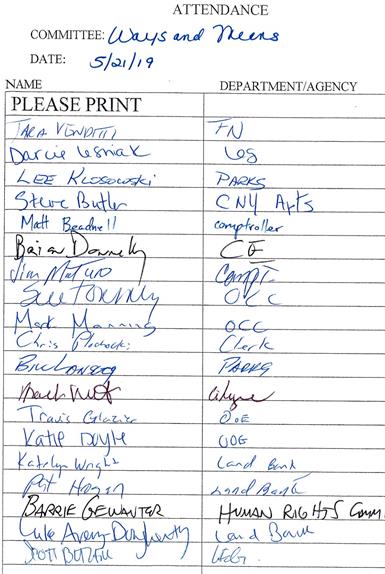
* * *
SPECIAL HEALTH COMMITTEE MINUTES - MAY 23, 2019
TIMOTHY T. BURTIS, CHAIRMAN
MEMBERS PRESENT: Mr. Bottrill, Mrs. Abbott-Kenan, Dr. Chase
MEMBERS ABSENT: Ms. Williams
ALSO ATTENDING: see attached list
Chairman Burtis called the meeting to order at 9:32 a.m. A motion was made by Dr. Chase, seconded by Mr. Bottrill to waive the reading of the minutes of the previous committee meeting; MOTION CARRIED. A motion was made by Dr. Chase, seconded by Mrs. Abbott-Kenan to approve the minutes of the previous committee meeting; MOTION CARRIED.
1. HEALTH DEPARTMENT: Dr. Indu Gupta, Commissioner
a. Confirming Appointment of Carolyn H. Revercomb, M.D., D.A.B.P. as Onondaga County Medical Examiner
Chairman Burtis:
Dr. Chase asked if Dr. Revercomb will be bringing any friends to fill the other positions. Dr. Gupta responded:
-
That is the hope, but one thing at a time; she will have to learn the department, and how it works
-
In continuous conversation with Dr. Revercomb in terms of recruitment - her effort is very important; has connectivity; worked in many different places and states; currently Deputy Medical Examiner in New Jersey at state level
-
Having a person at the top is first order of business, then can recruit others; additionally office is accredited; operationally works very well; once have head of Medical Examiner’s Office (MEO), then becomes more attractive
Mr. Bottrill asked Dr. Gupta to explain the Upstate relationship, what it was, and what it will be. Dr. Gupta replied:
-
In general, MEO’s may or may not be affiliated with academic institutions
-
If they do have opportunity, then would like affiliation, because it provides training for pathology residents - after 3 or 4 years in pathology, they need special forensic training to be Forensic Pathologist
-
Previously with Upstate, had academic appointment; residents were coming and interacting at MEO
-
Now moving forward – open door policy with Upstate; would like to have relationship, which has been communicated to Upstate Pathology Department; dependent on who comes in, and how they start process; Upstate is receptive
-
Compensation – salary schedule to provide opportunity to incoming Chief ME, Deputy or Forensic Pathologist
-
Any additional for Upstate will have to be conversation; certain things are built in
- Upstate will be contracted with County - anyone can work outside, but if using County facility, it should be with County
Dr. Gupta explained to Dr. Chase and Mr. Bottrill that the teaching responsibility is part of the day to day duties. Anything extra off premises would be outside the norm. If the MEO is used as a training ground for residents, then there would be a contract with Upstate Medical University and the County. Dr. Gupta responded to Dr. Chase that it would be included in the salary. Chairman Burtis stated that right now it is not part of the package. Dr. Gupta clarified that it will be part of her job responsibilities. Chairman Burtis said they do not have any income from Upstate, and Dr. Gupta agreed. Dr. Gupta said the expectation is that teaching is part of the ME’s responsibility within the premises of the MEO. If Upstate wanted anything additional outside of the MEO, it would be on the individual. When using a County facility, they have to ensure the County is reimbursed.
Dr. Gupta responded to Dr. Chase that adjunct is paid, and voluntary is voluntary. Lectures are usually voluntary and would be considered part of the training for the future generations. In house training would be part of the contract with the County and Upstate. If Upstate wants an adjunct to hire, then that is separate from the County and would be additional dollars. Mrs. Abbott-Kenan said that is how they justified the higher salary; having the relationship built in. Mr. Bottrill understands that adjunct is separate and asked if Dr. Revercomb would come to Dr. Gupta for permission. Dr. Gupta responded yes. First and foremost, anyone working for the County has a responsibility to the County. Anything additional is on an adjunct basis, and Upstate would have to hire Dr. Revercomb separately. It would be off premises with Dr. Gupta’s permission. It cannot impact regular work, because taxpayers are paying for it.
Chairman Burtis said that they are talking about the Chief Medical Examiner (County Medical Examiner), and this is being done according to the County Charter and Administrative Code.
A motion was made by Mrs. Abbott-Kenan, seconded by Dr. Chase, to approve this item. Passed unanimously; MOTION CARRIED.
A motion was made by Dr. Chase, seconded by Mr. Bottrill, to adjourn the meeting. Passed unanimously; MOTION CARRIED.
The meeting adjourned at 9:48 a.m.
Respectfully submitted,

JAMIE M. McNAMARA, Assistant Clerk
Onondaga County Legislature

* * * |



























